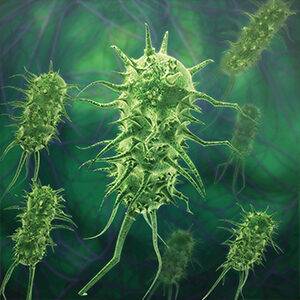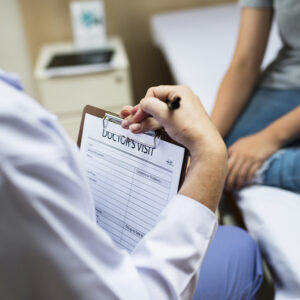What is campylobacteriosis?
Campylobacteriosis is a diarrheal illness caused by bacteria of the genus Campylobacter organisms. It is one of the most common causes of diarrheal illness in the United States and can cause disease in both humans and animals.
How do you get campylobacteriosis?
Most cases of campylobacteriosis are associated with eating raw or undercooked poultry (chicken, turkey, etc.). Even one drop of fluid from raw poultry could cause a person to become ill. One way people can become infected is through cross-contamination, for example, by cutting poultry on a cutting board and then using the inadequately washed cutting board or utensil to prepare vegetables or other raw foods. Infants may also become infected by contact with poultry packages in shopping carts.
Animals can become infected, and some people acquire infection from contact with the stool of an ill dog or cat, especially a young animal.
Campylobacteriosis usually occurs in single, sporadic cases, but it can occur in outbreaks, when a number of people become ill at one time. Outbreaks of campylobacteriosis are usually associated with unpasteurized milk, contaminated water, or improper cooking or handling of poultry. The organism does not usually spread from one person to another, but this can happen if the ill person is in diapers or is
producing a large volume of diarrhea.
What are the symptoms of campylobacteriosis?
Most people who become ill with campylobacteriosis have diarrhea, cramping, abdominal pain, and fever. The diarrhea may be bloody and can be accompanied by nausea and vomiting. Some infected persons do not have any symptoms.
How soon after infection do symptoms appear?
Symptoms usually begin within two to five days after exposure to the organism but can occur as soon as one day after exposure and up to ten days after exposure.
How long is a person ill with campylobacteriosis?
Most people recover within two to five days, but occasionally recovery can take up to ten days.
Does the infection of campylobacteriosis make a person immune?
A person who has had campylobacteriosis is likely to be immune to re-infection for years afterwards.
Are there complications associated with campylobacteriosis?
It is uncommon for Campylobacter infection to result in long-term consequences. However, Campylobacter occasionally spreads to the bloodstream and causes a serious lifethreatening infection. Some people develop arthritis. Others may develop a rare condition called Guillain-Barré Syndrome
(GBS) which begins several weeks after the diarrheal illness. GBS occurs when a person's immune system is "triggered" to attack the nerves, resulting in paralysis that lasts several weeks and usually requires intensive care. It is estimated that approximately one in every 1,000 reported Campylobacter illnesses leads to GBS. Campylobacteriosis is the most frequent cause of GBS.
Is there a vaccine for campylobacteriosis?
There is no vaccine for campylobacteriosis.
What can be done to prevent the spread of campylobacteriosis?
Some simple food handling practices can help prevent Campylobacter infections.
- Wash hands with soap before preparing food.
- Wash hands with soap after handling raw foods of animal origin and before touching anything else.
- Prevent cross-contamination in the kitchen by using separate cutting boards for foods of animal origin and other foods. Carefully clean all cutting boards,countertops, and utensils with soap and hot water after preparing raw foods. Do not rinse poultry products prior to cooking them as this can lead to further contamination of kitchen surfaces through splashing.
- Cook all poultry products thoroughly. Make sure that the meat is no longer pink and that juices run clear. All poultry should be cooked to reach a minimum internal temperature of 165°F.
- If you are served undercooked poultry in a restaurant, send it back for further cooking.
- Avoid consuming unpasteurized milk and untreated surface water.
- Make sure that persons with diarrhea, especially children, wash their hands carefully and frequently with soap to reduce the risk of spreading illness.
- Wash hands with soap after contact with pet or bird feces.

Communicable Disease Investigation & Prevention (CDIP)
Epidemiologists monitor, track, and respond to infectious disease in the community to prevent spread of illness.

